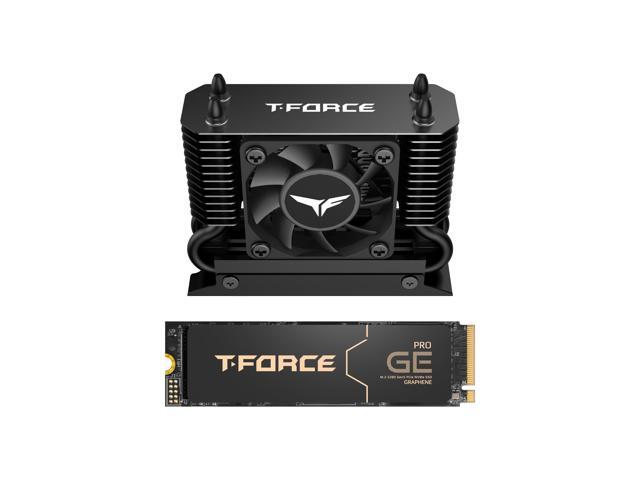Conclusion
The TEAMGROUP T-FORCE GE PRO AirFlow I 2TB PCIe Gen5x4 SSD marries TEAMGROUP’s new T-FORCE GE PRO PCIe 5.0 Gen5 NVMe SSD with TEAMGROUP’s T-FORCE DARK AirFlow I active heatsink and fan cooling. This complete Gen5 SSD package offers consumer-affordable storage and performance, with excellent cooling in TEAMGROUP’s T-FORCE line of SSDs. The TEAMGROUP T-FORCE GE PRO AirFlow I 2TB SSD is rated at up to 14,000MB/s sequential read and 11,800MB/s sequential write, based on the Innogrit IG5666 controller, 232-layer TLC 3D NAND flash, and a DRAM cache.
TEAMGROUP provides two different cooling options for the T-FORCE GE PRO, one with a graphene thermal heatspreader and one with the T-FORCE DARK AirFlow I pre-installed. Otherwise, both cooling options come in either a 1TB, 2TB, 4TB and 8TB capacity options, providing plenty of storage space. There are varying degrees of performance, though, with the 2TB and 4TB models being the fastest, and the 8TB model is not far behind. The T-FORCE GE PRO upgrades performance over the previous GC PRO and GA PRO.
FAN RPMs
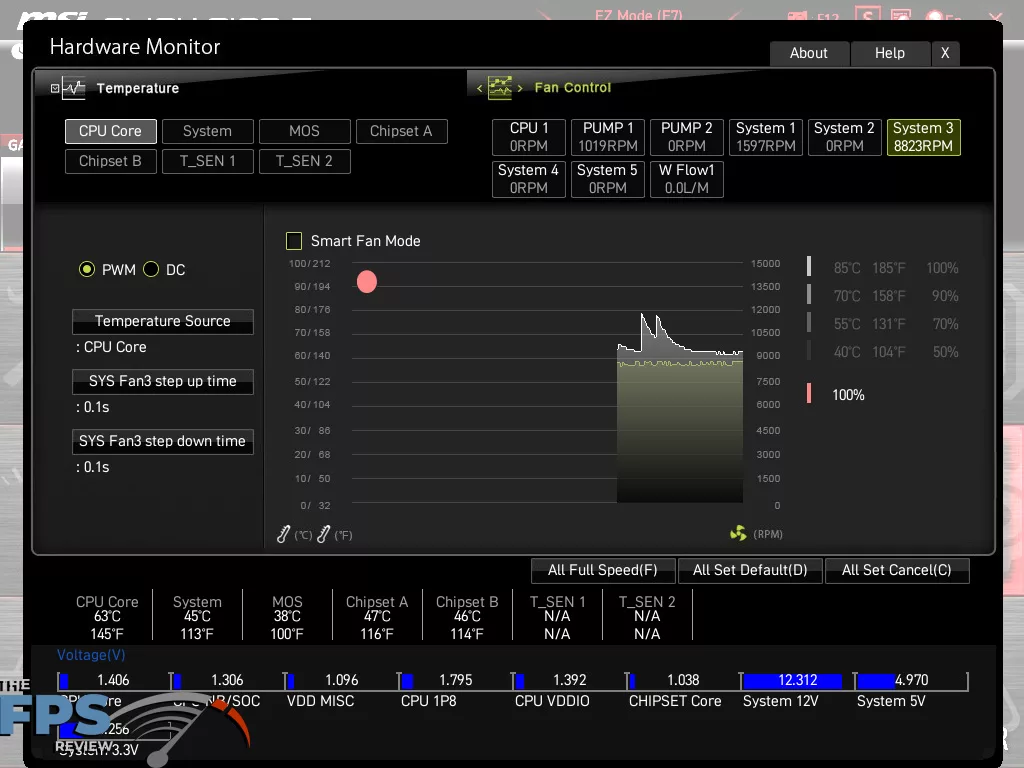
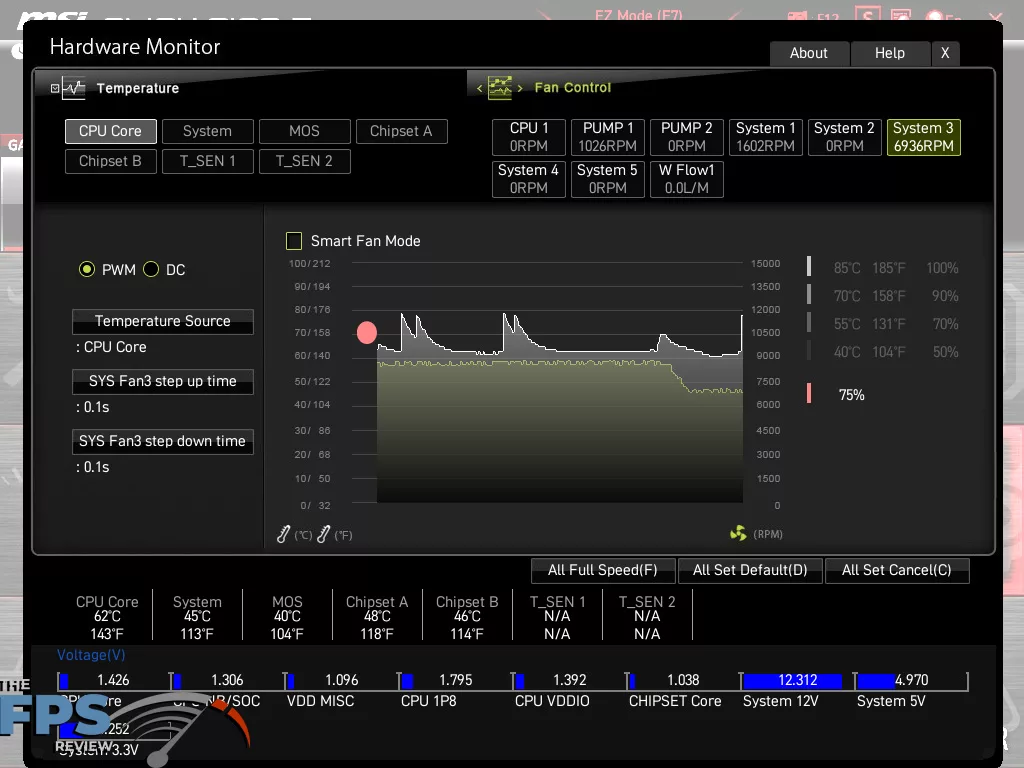
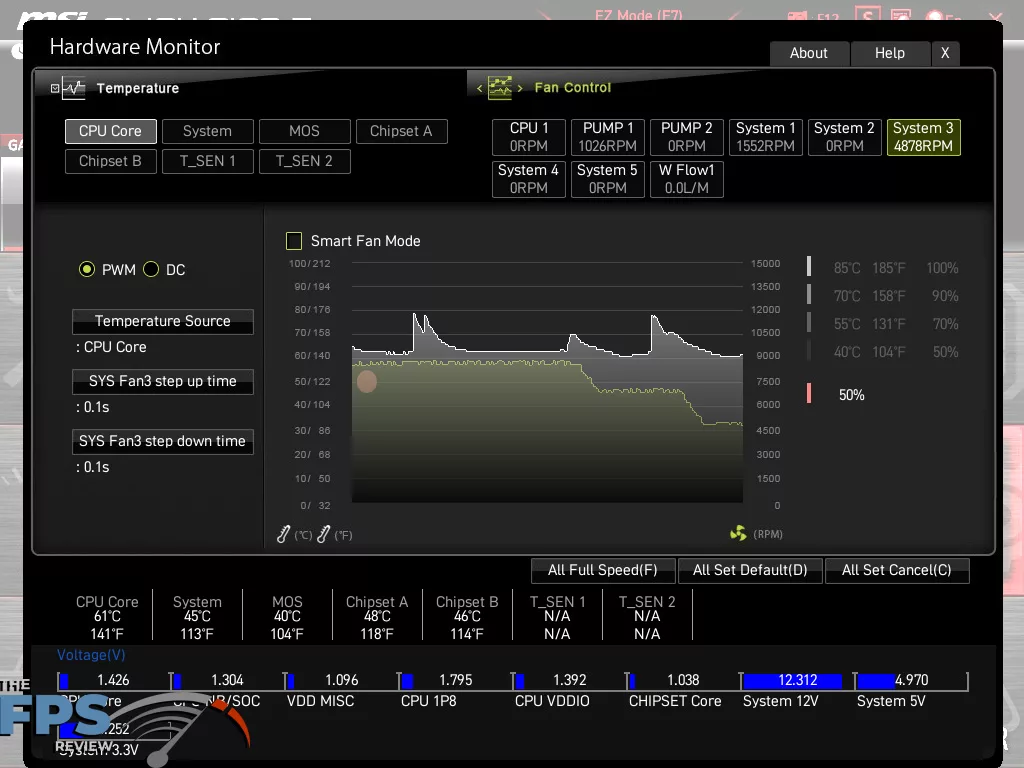
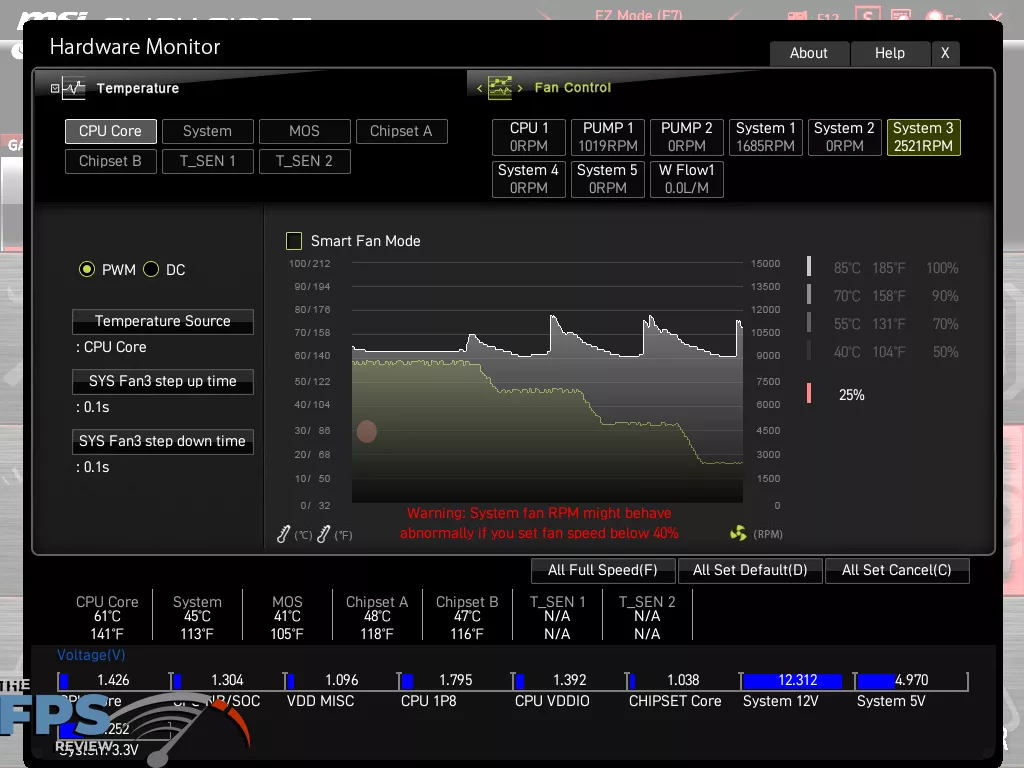
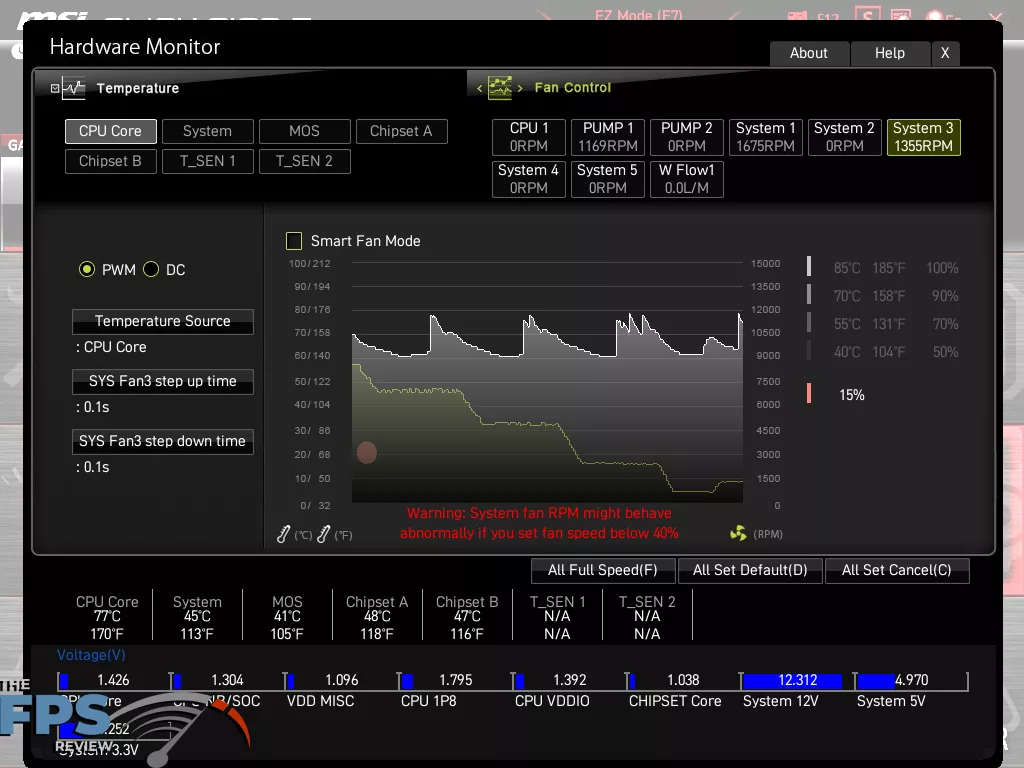
Connecting the TEAMGROUP T-FORCE GE PRO AirFlow I 2TB SSD to a 4-pin PWM system fan header on your motherboard allows you to control fan speed percentages or change to DC. In the above motherboard BIOS screenshots, we explored different percentages to see what RPMs the fan would run at. When 100% fan speed is set (the default), fan speeds can go as high as peaking at 8800RPM, but mostly settle in around 8500RPM, which is quite high and loud, with a whining scream. If we move the percentage down to 75% RPMs drop to the high 6000s, typically around 6800-6900RPM. At this level, the noise is still quite loud, and a noticeable whine can be heard.
Moving the percentage down to 50% is where we finally feel like the noise level is acceptable. At 50% the RPMs drop to around 4500-4800RPM, and this is finally the level where the noise is not a loud, pitchy whine noise. Furthermore, moving the percentage down to 25% completely removes any possible fan noise at all, and at 2500RPM, the fan noise is not an issue at all. Dropping down to 15% brings RPMs down to around 1300RPM.
On the noise level, this fan can certainly scream at the higher RPMs, which are typically the default. At 100% it is not tolerable; even 75% is a bit mind-numbing over time. We feel that at 50% is where the fan noise is tolerable, and will be fine inside most cases, you won’t hear it over the noise of other fans. The whine goes away, and all that is left is some wind noise. If you are building a more silent solution, then you’ll need to aim for 25% fan speeds, or RPMs in the 2400-2500RPM range. We would not go lower than that; however, this SSD can get hot, and active cooling is needed to keep it from thermal throttling.
Cooling
The goal of our temperature testing is to push the SSDs as hard as possible by performing a stress test of read and write. We run PerformanceTESTS’s advanced disk benchmark with a 10GB file, set to run each read/write test for 3 iterations, culminating in a 30-minute run. This is not typical usage behavior, but our goal is to find the maximum limits of the cooling. We utilize HWiNFO64 for reporting SSD temperatures.
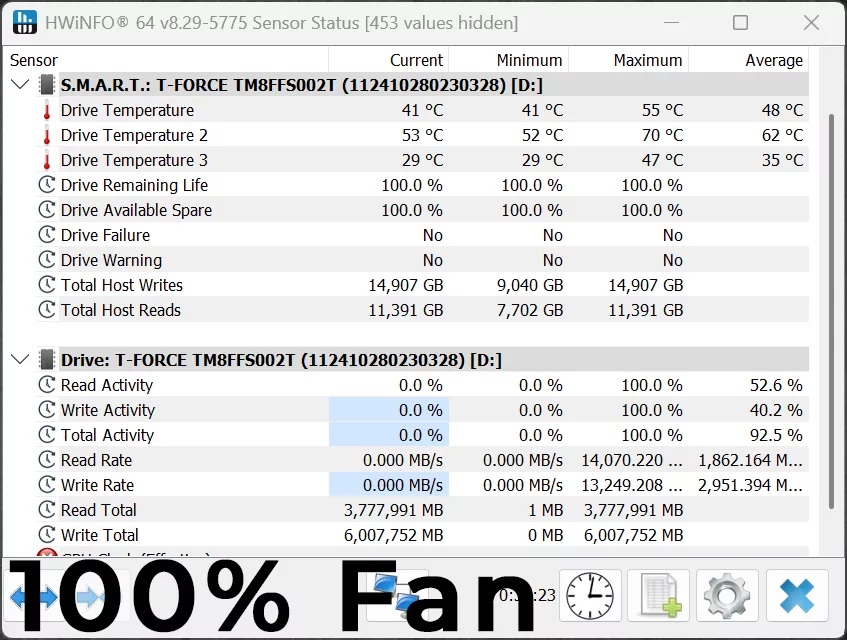
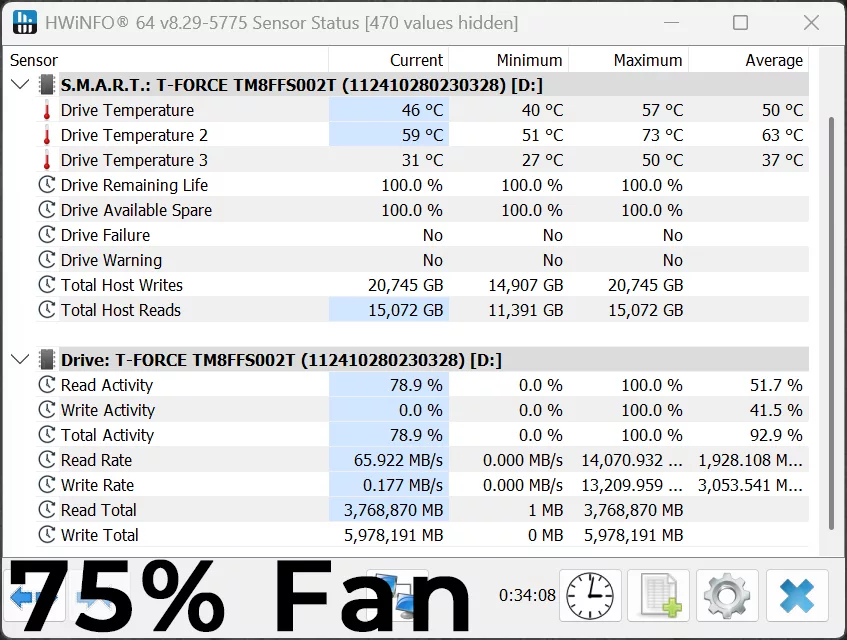
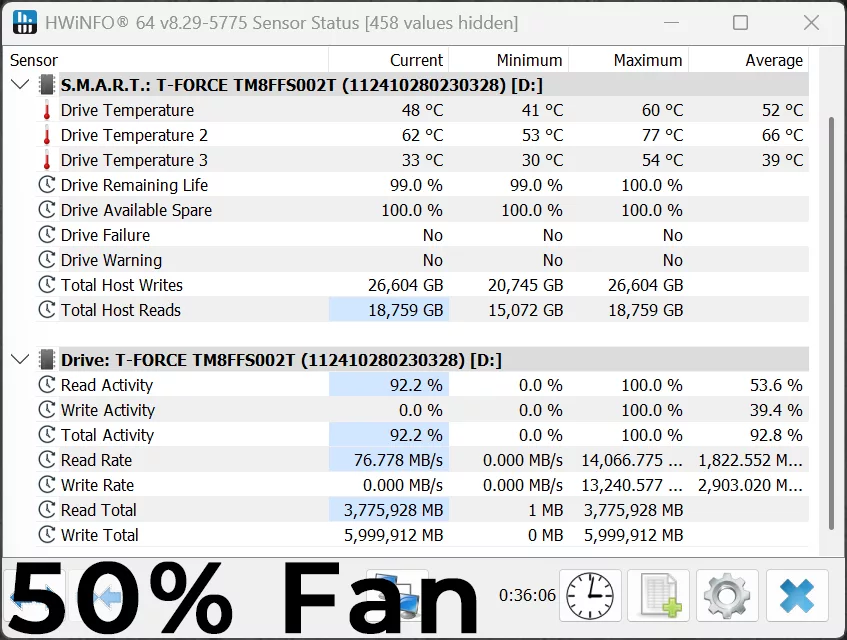
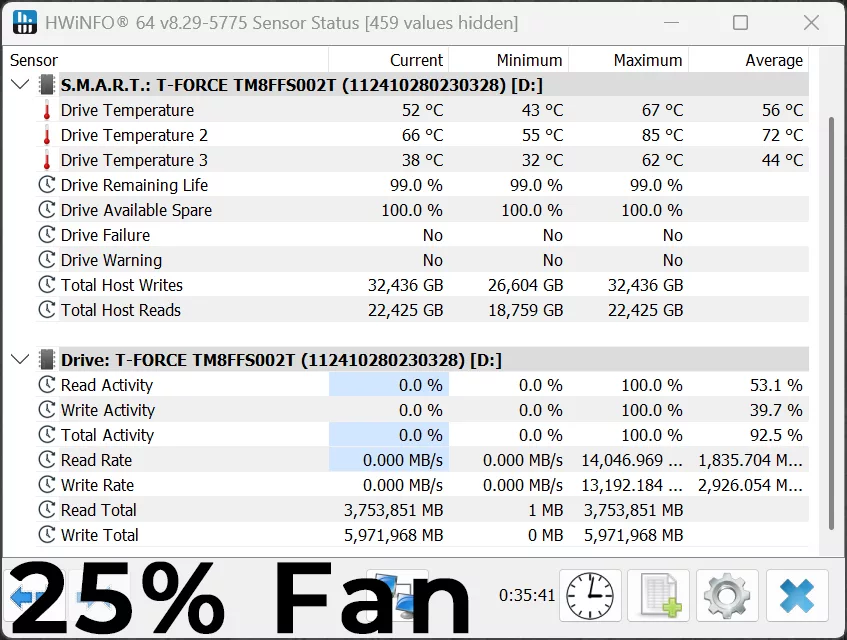
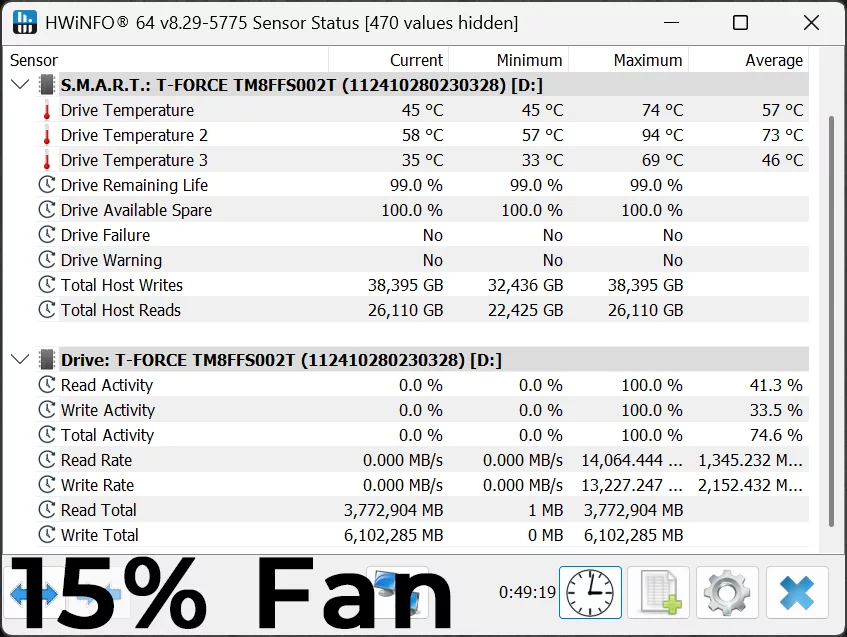
For temperature testing, we set each PWM fan percentage, as shown in the BIOS screenshots above, and did our full temperature test scenario using only the SSDs’ cooling, no external cooling. In the screenshots above, the first “Drive Temperature” is NAND flash or composite temperature, the “Drive Temperature 2” is the ASIC temperature, and “Drive Temperature 3” is NAND flash or composite temperature. Take note of the controller/ASIC temp in the Drive Temperature 2 reading.
At 100% fan speed, or default, the ASIC temperature maxes out at 70c in our intensive test, which is very acceptable in temperature for a Gen5 SSD. At 75% fan speed, the temperature climbs to 73c, still very tamed, and the NAND flash is alright as well. At 50% fan speed, the temperature climbs to 77c, still acceptable, but certainly starting to get warm. Note that it is here at 50% where we found is the best percentage to keep the noise level of the fan down, whereas 75% and 100% were very loud. Moving the percentage down to 50% only has about a 7c temperature difference from 100% to 50% for the ASIC.
At 25% and 15% is where things get toasty. At 25% fan speed, temperatures are hitting 85c on the ASIC, and the NAND flash/composite temp is rising as well. This could work, especially if you don’t do a lot of intensive writing, and it is mainly reading, then this will work fine, our test is very intensive. At 25% is where it works good for a silent PC. However, what you don’t want to do is drop below 25%, as you can see at 15% the temps are now over 90c at 94c on the ASIC, and NAND temps are over 70c, you are going to see thermal throttling. Even though the fan is running around 1300RPM, this isn’t enough on this small heatsink to actually provide enough cooling.
In terms of cooling, it is looking like 50% fan speed (4500RPM) is going to be the sweet spot for maintaining good temps, no thermal throttling, and balancing the noise level of the fan. Note also that if you in addition have external airflow, such as great case cooling, or a case fan blowing over this heatsink, then it will mitigate the heat issue and you can run lower RPMs on the SSD fan, much lower and get away with it, it does depend on your cooling setup. If you have little airflow, maintaining at least 50% PWM fan speed on this SSD will be important.
Final Points
The TEAMGROUP T-FORCE GE PRO AirFlow I 2TB PCIe Gen5x4 SSD performs well for the class and tier of PCIe 5.0 NVMe Gen5 SSD that it is. It uses the Innogrit IG5666 controller, and we had another SSD in our comparison, which also utilized this controller, the ADATA LEGEND 970 PRO. In all of our benchmark results, the TEAMGROUP T-FORCE GE PRO AirFlow I 2TB SSD surpassed it in performance by some decent and noticeable margins.
It was notably faster in PCMark 10’s quick storage benchmark, and PassMark, as well as faster in game load times, file copy, and professional workstation benchmarks. One area in which the TEAMGROUP T-FORCE GE PRO AirFlow I 2TB SSD improved upon the ADATA LEGEND 970 PRO was in the write performance bandwidth. It provided around 27% more write bandwidth performance consistently across the tests.
Overall, some of the strengths of the TEAMGROUP T-FORCE GE PRO AirFlow I 2TB SSD relate to the sequential read and write bandwidth, as well as RND4K Q32T16 read and write performance. One weakness relates to RND4K Q1T1 read and write performance. Since it does have a DRAM cache, it does well for smaller workloads and file sizes, where frequent lookup tables need to be read to and from the DRAM. It also seems that DirectStorage performance is very strong with this drive, and overall game load times are better than the ADATA LEGEND 970 PRO, but overall, on the lower end of performance, technically speaking.
The Innogrit IG5666 controller does underperform the competition, but it seems the TEAMGROUP T-FORCE GE PRO AirFlow I 2TB SSD is doing well to utilize what it has out of that controller, making efficient use of the controller’s potential performance. The TEAMGROUP T-FORCE GE PRO AirFlow I 2TB SSD does provide better performance than the ADATA LEGEND 970 PRO, which uses the same controller.
The TEAMGROUP T-FORCE DARK AifFlow 1 cooler on the TEAMGROUP T-FORCE GE PRO AirFlow I 2TB SSD is fantastic. We like the looks of it; overall, it has a very nice aesthetic that is pleasing for any computer build. With the fan being PWM, it can be bound to operate per-sensors that your motherboard supports, so it will be dependent on that; otherwise, you can control it via DC power, or manually with percentages in PWM mode.
It is unfortunate that SSDs do not have a temp sensor with which to bind PWM fans with, because tying it to your CPU temp is not going to correlate correctly to the SSD’s ASIC temperature. We recommend manually configuring the RPM/percentage, with 50% being the sweet spot for temps and noise levels. In our tests, it works well, but you will want it turned on; do not run with the fan disabled or removed, the SSD will thermal throttle without it.
Alternatively, you could remove the fan if you install your own external case fan directly blowing across this heatsink, but it would have to be of sufficient RPMs and static pressure to keep the heatsink cooled off well, but that is an option. Since you can remove the fan, flip it around to change the air direction, it does provide some customization. Of course, if you don’t want the T-FORCE DARK AirFlow I cooler at all, TEAMGROUP does have the T-FORCE GE PRO without it as well, as an option.
Make sure to check pricing on the TEAMGROUP T-FORCE GE PRO AirFlow I 2TB PCIe Gen5x4 SSD, at the time of writing, it is at an all-time low of $199 online for this model, which is appealing for what you get. TEAMGROUP offers you options with the T-FORCE GE PRO, with 1TB, 2TB, 4TB, and even 8TB capacities. You’ll have options for storage in large sizes, and with two different cooling options, pricing will vary as well between them. It is nice to have these options in an SSD product line, and the T-FORCE GE PRO gives you that.

